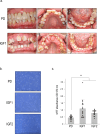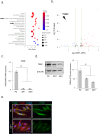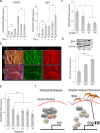Role of transglutaminase 2 in promoting biglycan synthesis in idiopathic gingival fibromatosis
- PMID: 39574071
- PMCID: PMC11583685
- DOI: 10.1186/s12903-024-05211-8
Role of transglutaminase 2 in promoting biglycan synthesis in idiopathic gingival fibromatosis
Abstract
Background: This study aimed to elucidate the pathogenesis of idiopathic gingival fibromatosis (IGF).
Methods: Human gingival fibroblasts (hGFs) were isolated from patients with IGF and periodontitis. Differential gene expression in the hGFs was analyzed using RNA sequencing. Extracellular matrix-related gene expression in the hGFs was analyzed. The effect of specific protein (SP)1 inhibitor or recombinant human transglutaminase 2 (rh-TGM2) on biglycan (BGN) expression in hGFs was also determined.
Results: RNA sequencing showed that TGM2 expression was downregulated and BGN mRNA expression was upregulated in patients with IGF relative to periodontitis. rh-TGM2 stimulation of hGFs in patients with IGF significantly reduced BGN expression. SP1 inhibitors downregulated BGN expression in the hGFs.
Conclusion: BGN upregulation via SP1 causes TGM2 downregulation in gingival fibroblasts in IGF.
Keywords: Biglycan; Human gingival fibroblast; Idiopathic gingival fibromatosis; Periodontitis; Specific protein 1; Transglutaminase 2.
© 2024. The Author(s).
Conflict of interest statement
Declarations. Ethics approval and consent to participate: The study protocol was approved by the research ethics committees of Hiroshima University (E2015-0001), and written informed consent was obtained from the subjects. Consent for publication: Consent for publication was obtained from the participants. Competing interests: The authors declare no competing interests.
Figures




Similar articles
-
miR-148a-3p regulates proliferation and apoptosis of idiopathic gingival fibroma by targeting NPTX1.Oral Dis. 2024 May;30(4):2136-2149. doi: 10.1111/odi.14655. Epub 2023 Jun 25. Oral Dis. 2024. PMID: 37357360
-
Testosterone stimulates proliferation and inhibits interleukin-6 production of normal and hereditary gingival fibromatosis fibroblasts.Oral Microbiol Immunol. 2002 Jun;17(3):186-92. doi: 10.1034/j.1399-302x.2002.170309.x. Oral Microbiol Immunol. 2002. PMID: 12030972
-
Advanced glycation end-products increase IL-6 and ICAM-1 expression via RAGE, MAPK and NF-κB pathways in human gingival fibroblasts.J Periodontal Res. 2018 Jun;53(3):334-344. doi: 10.1111/jre.12518. Epub 2017 Nov 30. J Periodontal Res. 2018. PMID: 29193068
-
Biological effects of interleukin-6 on Gingival Fibroblasts: Cytokine regulation in periodontitis.J Cell Physiol. 2018 Sep;233(9):6393-6400. doi: 10.1002/jcp.26521. Epub 2018 Mar 25. J Cell Physiol. 2018. PMID: 29574949 Review.
-
Transglutaminase 2-mediated histone monoaminylation and its role in cancer.Biosci Rep. 2024 Aug 28;44(8):BSR20240493. doi: 10.1042/BSR20240493. Biosci Rep. 2024. PMID: 39115570 Free PMC article. Review.
References
-
- Ko YCK, Farr JB, Yoon A, Philipone E. Idiopathic gingival fibromatosis: case report and review of the literature. Am J Dermatopathol. 2016;38:e68–71. - PubMed
-
- Yin S, Jia F, Ran L, Xie L, Wu Z, Zhan Y, et al. Exosomes derived from idiopathic gingival fibroma fibroblasts regulate gingival fibroblast proliferation and apoptosis. Oral Dis. 2021;27:1789–95. - PubMed
MeSH terms
Substances
Grants and funding
LinkOut - more resources
Full Text Sources
Molecular Biology Databases
Research Materials
Miscellaneous

